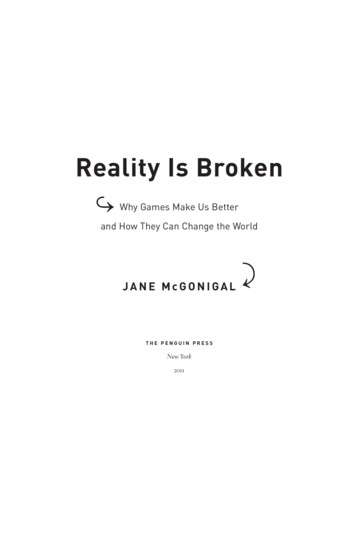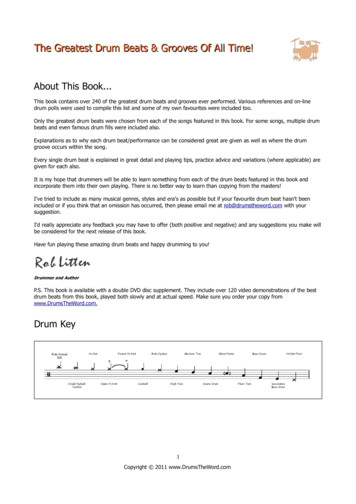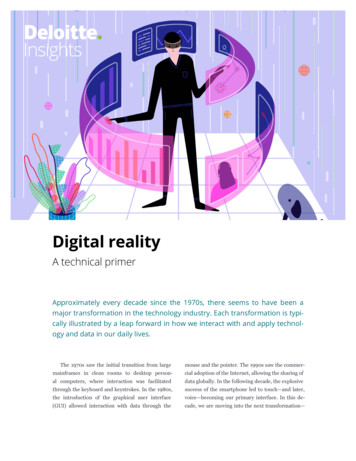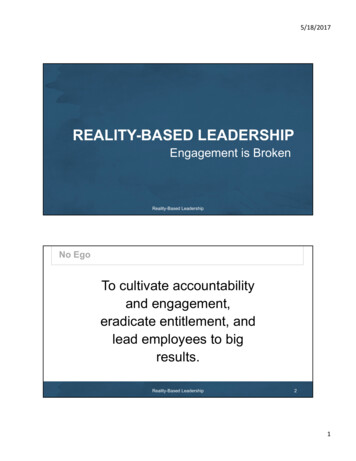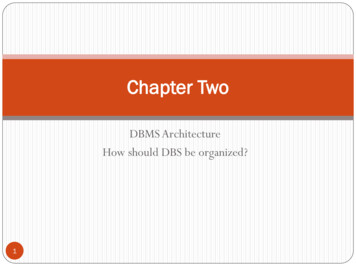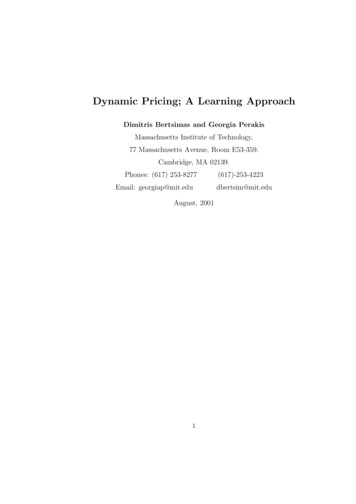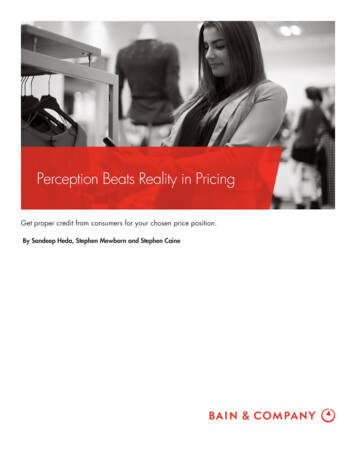
Transcription
Perception Beats Reality in PricingGet proper credit from consumers for your chosen price position.By Sandeep Heda, Stephen Mewborn and Stephen Caine
Sandeep Heda, Stephen Mewborn and Stephen Caine are partners with Bain &Company’s Customer Strategy & Marketing and Retail practices. Mewbornleads Bain’s global pricing work and is based in Chicago. Heda and Caine arebased, respectively, in Atlanta and Chicago.ROI Consultancy Services provides full-service research, marketing and salesautomation, and digital agency support to consultants, investors and corporateclients. For details, visit www.roiconsultancyservices.com or contact Noah Seton(noah.seton@roirocket.com).Copyright 2016 Bain & Company, Inc. All rights reserved.
Perception Beats Reality in PricingWhen managers make decisions on pricing, a fundamental question sometimes goes unasked: Will customers notice?Price wars have broken out in consumer industriesaround the world. It’s no secret that retailers such asALDI, Amazon and Walmart have used price to position themselves against traditional competitors in theirmarkets, pinching margins all around. Financial assetmanagers have been out-price-cutting one another inexchange-traded funds in a bid to gain market share.Major US telecommunications carriers now competefiercely on price as they try to win new customers. Andairlines are gearing up for a price war on trans-Atlanticroutes as some low-cost carriers plan service betweenthe US and Europe.All too often they do not, and what ultimately matters ishow customers perceive the price point. Most companies—luxury purveyors aside—want to be perceived byconsumers as having lower prices, relative to competitors, than actual shelf prices warrant. A retailer with average prices that are 10% higher than a key competitor’swould love to be perceived as being only 5% higher.If consumer perception does not align with the company’s intent, expensive investments in tactics such ascoupons will be undercut. Other techniques, such assignage and clear communication, may cost less andhelp consumers understand a brand’s position in theprice-value equation. Lower-cost alternatives often do asimilar or better job of improving perception than thetactic of reducing the actual list price.These companies are reducing prices because they believe that will boost their perceived value to consumers,who implicitly weigh price against product featuresand benefits in their purchase decisions. As pressureintensifies to reduce prices, either by cutting the listprice or offering a discount, companies may act hastily,without the same rigor they apply to investments elsewhere, such as capital deployment or product enhancements. Yet, changing prices can have an even greatereffect on company financials.There are clear winners and losers in the battle for pricing credit from consumers. Bain & Company and ROIFigure 1: Retailers get more or less credit from consumers for their shelf pricesPerceived price premium*15%Unfavorable: perceived price is higher than actual price1050–5–10–15–15Favorable: perceived price is lower than actual price–10–50Actual price premium*510Retailers*Average relative to competitorsNotes: Actual prices are based on sample basket of goods collected through store visits; perceived prices are from survey respondents’ store-price imageSource: Bain/ROI Consultancy Services (formerly PollBuzzer) consumer survey and store visits in Atlanta and Washington, DC, 2016 (n 2,155)115%
Perception Beats Reality in PricingConsultancy Services (formerly PollBuzzer) recentlysurveyed almost 2,200 consumers in Atlanta andWashington, DC, about the prices at eight retail chainscarrying groceries. We found that retailers get more orless credit for their pricing than actual shelf priceswould suggest (see Figure 1).value equation. Bain’s grocery survey shows that half ofconsumers’ monthly spending goes to stores that arenot the consumer’s primary store.Managing price perception, not just pricing structureand actual price points, thus has become a critical capability for firms in consumer markets.For example, one retailer’s reputation as an upscalediscounter, built through its store and product design,has given consumers the perception that it charges aprice premium, when in fact its prices run slightly lower than the average in the two cities. Its pricing strategydoes not mesh with its overall proposition to customers, with the result that the retailer does not get thepricing credit it deserves. One option for improvingthe situation might be for the retailer to raise its pricesslightly, since customers have already baked the premium into their shopping decisions.Mapping a path to improved perceptionSo how can companies get more credit from consumers beyond shelf price in order to build traffic and earnloyalty with their target customers?Companies can choose among more than 15 tactics inthese four categories: offering lower prices, shoutingout those prices, giving great deals and tailoring theexperience (see Figure 2). The right combination, ofcourse, depends on a company’s sector, strategy andproposition to customers.In another example, many consumers believe that Amazon offers at or near the lowest prices on a broadrange of goods, even when that’s not the case. In fact,Amazon strategically selects the products, such as bestselling items, on which to compete aggressively andcharges relatively more on others. In one study,Jet.com was cheaper than Amazon by 27%. Thisdynamic plays out in other industries as well. Southwest Airlines, an early low-cost carrier, is still widelyperceived as a low-price leader, yet some studies haveshown that its price advantage has eroded over time.The continued perception of low-price leadership iseven more remarkable considering Southwest bundleschecked baggage with the price of the ticket, while other carriers have lower price points for passengers traveling with only carry-on bags.A traditional grocer that caters mainly to higherincome customers, for instance, needs to have thewhole assortment of grocery items and strong perceived quality. It would focus on very targeted moves,including key value items, promotions and signage,rather than on tactics that would significantly changethe proposition, such as out-of-store advertising, pricematching or coupons.A discount grocer, by contrast, typically uses privatelabel goods to influence price perceptions. Since itscustomers are less sensitive to product quality andbreadth, the discounter can offer a narrower assortment, letting it present a lower-price and lower-end image in stores.Intense competition on pricing pervades many industries, which makes consumer perception more important than ever. Aggregator and comparison websiteshave brought greater price visibility and ease of product comparison to banking, insurance, hotels and other consumer markets. It’s also easier for consumers tosplit their spending among different providers, depending on which firms offer the best perceived price-To determine which of these tactics to deploy, a company should first gain a deeper understanding of itscurrent price position vs. consumers’ perceptions.Checking its prices against competitors’ prices on comparable items will reveal actual price gaps. Then, determining consumers’ perceptions will show whether andhow they perceive those price gaps.2
Perception Beats Reality in PricingFigure 2: Various tactics can influence price perceptionPrice-point policies(e.g., ending digit)tied to compategynystrstraatginCoupon offeringPricLow known valueitem pricesPromotionbreadth and depthLoyalty or rewardsprogram designDifferentiatedvalue propositionIn-store signageAssortment mix(good/better/best)Private labelOut-of-storeadvertising; circularsStore look and feelMarketing tactics(e.g., price matching)Tailor the experienceShout out pricesGive great dealsConsistently low listor tag pricesvers that optimtion leizecepstrare-ptegceiyrPyegOffer low pricesPrice hierarchy (e.g., everydaylow or coupon heavy)Customer serviceSource: Bain & CompanyExecuting a pricing strategy effectively requires that allthe relevant parts of the organization—merchandising, marketing, operations, suppliers and the seniorexecutive team—agree on the pricing strategy itselfand on the tactics to shape accurate perceptions. Teamsresponsible for pricing can then continually experiment with pricing tactics to learn what works with particular segments of customers.The next task is to identify the factors that have the strongest influence on perception. These can be gleanedthrough in-store visits and surveys asking consumersabout the retailer’s signage, promotions and so on. Theiranswers can be compared with responses giving more orless credit than deserved on price positions. If consumers perceive that a chain’s prices are lower than they really are, the analysis can home in on the areas in whichconsumers think the retailer outperforms.The experience of a European discount apparel retailerillustrates the power of a disciplined price-perceptionprogram. Facing stiff competition from other fashiondiscounters, the retailer fought back by slashing pricesacross the board but did not realize the anticipatedbenefits in price image and sales volume. It decided tostep back and take a more nuanced approach. The retailer analyzed its price positions and customer perceptions, which yielded important insights. In a nutshell,consumers incorrectly perceived that the company hadhigher prices than its key competitor. One reason wasData on the factors forming perception is the foundation of a plan to build an effective price image. Theplan will likely include a mix of direct price changesand indirect tactics like rewards programs. Insightsfrom surveys and store visits should link directly to thecompany’s strategy so that every subsequent pricemove will create the greatest possible value and staytrue to the brand. While pricing perception will advance the overall strategy, it’s not the whole solution;pricing perception should be combined with a solidshelf-price structure.3
Perception Beats Reality in PricingFigure 3: How an apparel retailer defined rules and tactics for product categoriesPrice sensitive?YesNoYesImage buildersKey value categories Target prices above company’s average Target prices below company’s average Selectively adjust markups to increase gross margins Ensure that entry prices are competitive with value discounters Promote in media, by using entry prices Allow for larger discounts and promotions Increase breadth and depth for entry price pointsObserved halo effect? Push for price promotions Focus price communications and visual merchandisingon items within these categoriesMargin enhancersOpportunistic categories Target prices above company’s average Set prices to optimize volumes and margins(high-elasticity categories)No Adjust markups to increase gross margins Push for price promotions Ensure breadth of assortment Ensure price communications in store Promote fashion content, fit and quality rather than priceSource: Bain & Companythat the retailer offered far more price points than itscompetitors, which confused people. Also, the company discovered that customers were more price sensitive about certain product categories, like children’sT-shirts and adults’ sweaters.don’t give the company sufficient credit on its relativeprice position. Using and properly implementing moreindirect tactics, such as signage and private label, onthe other hand, may have an outsized impact on pricing perception—a proven and effective route to sustainable gains and profitable revenue growth.The retailer defined clear roles for product categories,based on customers’ perceptions of products andwhether a category has a halo effect, influencing howpeople perceive the retailer’s value overall (see Figure 3).It refined communications about pricing so they wereconsistent with the price images the retailer wanted toportray, and it reduced the number of price points. Asa result of the program, the company was able toachieve its target price image, develop stronger internal pricing capabilities and grow revenues by roughly 1%.As this retailer discovered, there is a lot more to pricingpower than just adjusting prices. Directing investments to lower prices may not supercharge sales.Worse, it might backfire if consumers’ perceptions4
Shared Ambit ion, True ResultsBain & Company is the management consulting firm that the world’s business leaders cometo when they want results.Bain advises clients on strategy, operations, technology, organization, private equity and mergers and acquisitions.We develop practical, customized insights that clients act on and transfer skills that make change stick. Foundedin 1973, Bain has 53 offices in 34 countries, and our deep expertise and client roster cross every industry andeconomic sector. Our clients have outperformed the stock market 4 to 1.What sets us apartWe believe a consulting firm should be more than an adviser. So we put ourselves in our clients’ shoes, sellingoutcomes, not projects. We align our incentives with our clients’ by linking our fees to their results and collaborateto unlock the full potential of their business. Our Results Delivery process builds our clients’ capabilities, andour True North values mean we do the right thing for our clients, people and communities—always.
Key contacts in Bain’s Customer Strategy & Marketing and Retail practicesAmericasStephen Caine in Chicago (stephen.caine@bain.com)Sandeep Heda in Atlanta (sandeep.heda@bain.com)Stephen Mewborn in Chicago (stephen.mewborn@bain.com)Asia-PacificDavid Zehner in Sydney (david.zehner@bain.com)Europe,Middle Eastand AfricaGrégoire Baudry in Paris (gregoire.baudry@bain.com)For more information, visit www.bain.com
Perception Beats Reality in Pricing 1 Price wars have broken out in consumer industries around the world. It's no secret that retailers such as ALDI, Amazon and Walmart have used price to posi- . Perception Beats Reality in Pricing don't give the company suffi cient credit on its relative price position. Using and properly implementing more
